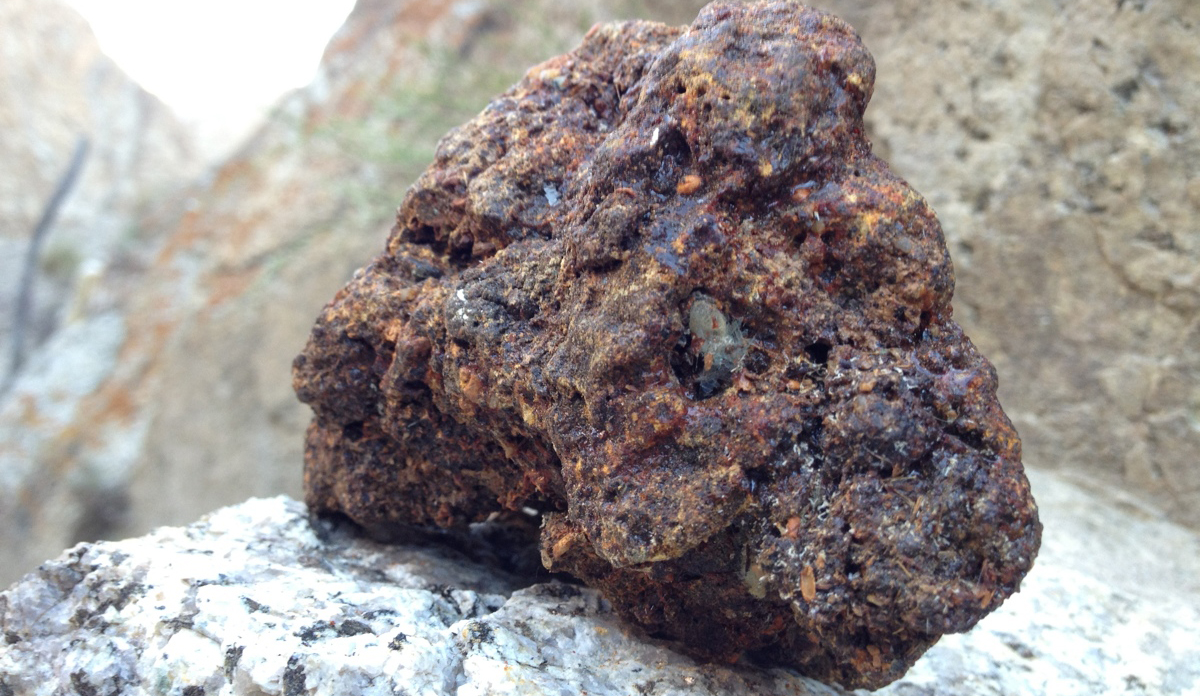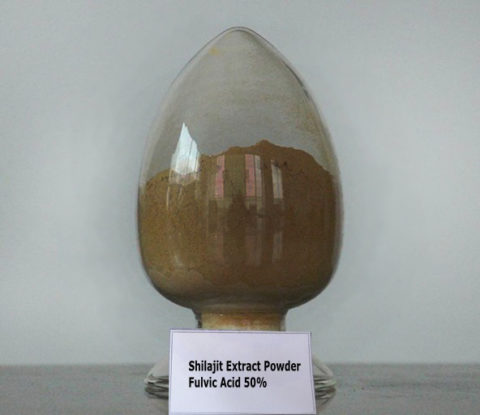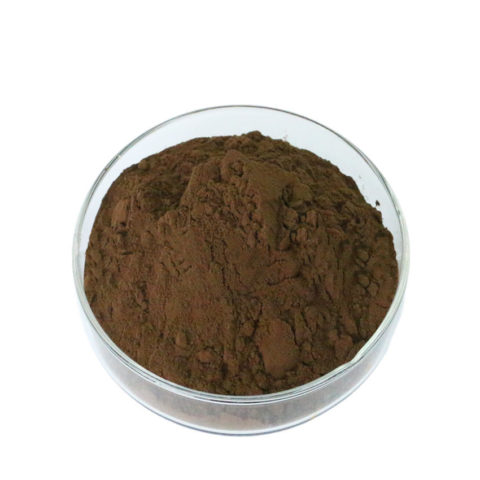
Himalayan Shilajit Extract Powder Fulvic Acid 40%,45%,50%
Shilajit is has been used as a folk medicine for over 3000 years as a rejuvenator and adaptogen in India and Tibeta in China.
Shilajit Extract Powder
【Latin Name】: SHILAJIT Asphaltum (Shilajit)
【Derivation of name】: Obliquus means “slanted” or “oblique.”
【Active ingredients】: Fulvic Acid
【Specification】: 10:1, 20:1, Fulvic Acid 5%, 20%,30%, 40%,45%,50%
【Test Method】: TLC&Titration method
【Appearance】: Brownish fine powder
【Particle size】: 100% pass 80 mesh
【Main Function】: Natural a-phrodisiac, immunity enhancer, promoting physical strength and endurance.

Shilajit extract is a potent and very safe dietary supplement, potentially able to prevent several diseases, but its main medical application now appears to come from its actions in benefit of cognition and potentially as a dietary supplement to prevent Alzheimer’s disease. Shilajit is a rejuvenator (‘Rasayana’) of traditional Hindu Ayurvedic origin, which clearly has attracted considerable interest in India. Ayurvedic pharmacology classifies medicinal substances into different groups (e.g. ‘Rasayana’) according to their actions. Rasayana medicines improve the quality of ‘Rasa’ (plasma) and thus strengthen or promote the health of all tissues of the body. Shilajit is blackish-brown exudation of variable consistency obtained from the steep rocks of different formation found in the Himalayas at altitudes between 1000-1500 m, from Arunachal Pradesh in the East, to Kashmir in the West. Shilajit is also found in other mountain ranges of the world, e.g., Afghanistan(Hinduksh, Badakh-Shan), Australia (Northern Pollock Ranges) and in the former USSR (Tien-Shan, Pair, Cancasus, Ural).
Shilajit has urinous odour and slight bitter, saline, somewhat pungent and astringent taste. The purified substance is nearly completely soluble in water and has an acid reaction. Shilajit is not a rock but a complex mixture of organic humic substances and humic nature, plant and microbial metabolites occurring in the rock rhizospheres. It is also called, Momio in Persian, myemu in Russian and mumie in German. Shilajit has been used for thousands of years, in one form or another, under the indigenous systems of medicine such as Ayurveda, Siddha and Unani. It is bitter in taste and its smell resembles pungent cow’s stale urine. Shilajit, an ancient traditional medicine has been ascribed a number of pharmacological activities and has been used for ages as a rejuvenator and for treating a number of disease conditions. Shilajit is one such remedy, which has been in use as a folk medicine for over 3000 years as a rejuvenator and adaptogen. Shilajit mainly consists of pale humus (around 80–85 %) and organic compounds derived from vegetation fossils that have been compressed under layers of rocks for hundreds of years and have undergone a high amount of metamorphosis due to the high temperature and pressure conditions prevalent there.
Varieties of Shilajit
There are four different varieties of shilajit which have been described in charka samhita, namely savrana, rajat, tamra and lauha shilajit. Savrana shilajit is gold shilajit and is red in colour. Tamra is a copper shilajit and is blue in colour. Rajat is a silver shilajit and is white in colour while the lauha shilajit is an iron-containing shilajit and is brownish-black in colour. Blue and Gold Shilajit are not found commonly and the variety mostly available is the Iron Shilajit which, from the therapeutic point of view, is considered to be active.
Origin of Shilajit
There are many scientists who claim that shilajit exuding from a layer of rocks of mountains is basically of vegetative origin. Shilajit was variously described as bitumen varying greatly in consistency from a free flowing liquid to hard brittle solid; a mineral resin, a plant fossil exposed by the elevation of the Himalayas, a substance of mixed plant and animal origin and an inorganic material. Latex bearing plants, namely Euphorbia royleana Boiss and Trifoleum repens which occur in the vicinity of the shilajit bearing rocks are thought to be the most likely source of shilajit. Other recent research claims that the mosses of species such as Barbula, Fissidenc, Minium, Thuidium and species of Liverworts like Asterella, Dumortiera, Marchantia, Pellia, Plagiochasma and tephenrencellaAnthoceroswere present in the vicinity of shilajit-exuding rocks and these bryophytes are responsible for the formation of shilajit.
Chemical Composition
Considerable controversy had existed in the reported literature on the nature and chemical constituents of Shilajit. It was reported to contain resins, fatty acids, benzoic and hippuric acids, albuminoids, amino acids and a number of minerals. Extensive chemical studies by Ghosal et.al have indicated the occurrence of oxygenated biphenyls and three oxygenated 3, 4-benzocumarins, several phenolic, amino acid and triterpines in Shilajit. Shilajit contains two classes of organic compounds, namely:
(1) Humic substances
(2) Non-humic organic metabolites
Humic substances are the major organic constituents of Shilajit present in an amount of about 80-85%. The humic substances can be further divided into three fractions:
1. Fulvic acids (Fas)
2. Humic acids (Has)
3. Humins (HMs)
The Fas micropores of Shilajit are occupied by low molecular weight. Bioactive molecules e.g oxygenated dibenzene-alpha-pyrones and their dimeric and oligomeric equivalents, other low molecular weight phenolic entities and Fas of Shilajit act as an efficient carrier of several classes of d-rug molecules for uninterrupted systemic distribution and absorption. The non-humic substances of Shilajit are low molecular weight compounds of marine fossil, plant, and microbial origin, occurring in and around Shilajit bearing rocks. The remaining non-humic organic masses in Shilajit comprise a mixture of low molecular weight aromatic, aliphatic alicylic and heterocylic (N- and S- containing) compounds of particular biological interest are low molecular weight oxygenated dibenzo-alpha-pyrines (DBP) and hydroxyl acetophenones (HAPS). The two oxygenated dibenzo-alpha-pyrones, viz 3-hydroxydibenzo-alpha-pyrone and 3, 8 dihydoxy dibenzoalpha-pyrone occurred both in the free form in the micropores of Has and Fas and also in conjugated forms in the humus of Shilajit.
Researches on Shilajit Extract Benefits
1. Anti-ulcerogenic / Anti-stress – Adaptogenic Activity
Shilajit extract was found to possess anti-ulcerogenic effects by its ability to decrease gastric acid secretion and peptic output and was also found to be effective in restrain stress models. The adrenocortical response to stress appears to be a common mechanism for the anti-stress / adaptogenic activity. Shilajit treatment produced decreased ulcerogenicity in 4 hr pylorus ligated rats. This finding lends credence to the suggested use of shilajit for peptic ulcers. Shilajit increased the carbohydrate/protein ratio and decreased gastric ulcer index, indicating an increased mucus barrier. These results substantiate the use of shilajit in peptic ulcer. Some active constituents isolated from shilajit are Fulvic acid and 4/-methoxy 6-carbomethoxy bi phenyl.
These active constituents were found to have ulcer protective effect as a result a per se decrease in acid-pepsin secretion and cell shedding. They studied the effects of the Shilajit constituents, fulvic acids (FA) and 4’ –methoxy-6-carbomethoxybiphenyl (MCB) against gastric ulcers induced by restraint stress and aspirin in pylorus ligated albino rats as well as in cysteamineinduced duodenal ulcers in rats. Both FA and MCB were effective and decreased the incidence of duodenal ulcers in the experimental model. For the first part of the study, to determine the efficacy of Shilajit constituents on the development of restraint stress and aspirin-induced ulcers, albino rats were divided into groups 8 groups of 7-12 animals each.
• Group 1 was given saline (control group).
• Group II received FA at 50 mg/kg level twice daily for 6 weeks.
• Group III received 100 mg/kg FA twice daily for 6 weeks.
• Group IV received MCB 100 mg/kg twice daily for 6 weeks.
• Group V received FA+MCB (25 + 25 mg/kg) once daily for four weeks.
• Group VI received aspirin (ASP, an ulcerogenic agent) 200 mg/kg once daily for 3 weeks.
• Group VII received ASP + ACB (200 mg/kg once daily for 3 weeks + 50 mg/kg once daily for four weeks.
• Group VIII received Aspirin +FA (200 mg/kg once daily for 3 weeks + 50 mg/kg once daily for four weeks) In the second part of the study, FA (50 mg/kg) or MCB (100 mg/kg) was administered twice daily for 5 days. The animals were fasted overnight and then treated with 30 mg/kg cysteamine subcutaneously.


Both FA and MCB isolated from Shilajit significantly decreased the restraint-stress ulcer index in pylorus ligated albino rats as compared to the control and the aspirin-treated groups, FA being more effective (Fig. 1). FA+MCB also retained the efficacy in the duodenal ulcers experimental model (Fig. 2). In the first part of the study, evaluation of the results with MCB revealed that the compound alone and in the presence of aspirin decreased the volumes of gastric secretion and the acid and peptic output significantly, as compared to the control as well as the aspirin treated groups. MCB had practically no effect on the protein content of the gastric juice, but it reversed the adverse effects of aspirin. MCB had a favorable effect on the total carbohydrate: protein ratio in the gastric juice, indicating that it stimulates the secretion of mucus.
2. Shilajit Extract as an Immunomodulator
Ghosal et al.9 also investigated the immunomodulatory potential of shilajit constituents. The screening was done on three crucial parameters, viz.
1. elicitation and activation of peritoneal macrophages,
2. their effect on the lysosomal marker enzyme (acid phosphatase),
3. effects on tumor cells.
In all the selected immunological parameters, FA and MCB showed significant immunostimulatory effects. This makes shilajit a useful agent as promoter of non-specific immunological defense. Shilajit treatment not only induced morphological and morphometric changes on the peritoneal macrophages, it also dose dependently augments the phagocytic activity. This was validated in another study by the same authors, wherein they studied the effects of processed Shilajit on mouse peritoneal macrophages. In this study, the dose and time-dependent effects of processed Shilajit (SJP) on the structure and functions of mouse peritoneal macrophages was evaluated. 0.025 to 900 mcg per mouse intraperitoneally for different periods of time upto several hours. SJP (300-900 mcg ) produced morphological changes in the adherant cells in the peritoneum in a dose-dependent manner. The results on cell size are shown in Fig. 3.


The shape of the macrophage cell body appeared to be heterogeneous and the cells were found to be constituents of an intricate network. There were round and elongated cells and the axes of extension increased progressively with time (Fig. 4) The dose and time dependent effects exhibited by SJP (Fig. 4) lend support to the postulate made by earlier researchers that the immunological response could be due to a direct interaction with the target cells or through secretory-type cells. The phagocytic index depended on the function of the individual activated macrophage and not upon the number of macrophages present. A significant observation from this study was that higher doses of SJP (7.5 to 15 mcg) produced “greedy” macrophages that were subjected to lysis and disintegration. This observation is significant in that it indicates that the dose and duration of administration of Shilajit should be carefully configured to avoid impairment in the immunological response of the users. The dose dependent effect of systemic exposure to Shilajit on the phagocytic activity is shown in Fig 5.


3. Antiallergic Action of Shilajit Extract
Shilajit treatment also stabilizes mast cells and prevents its degranulation. The effects of Shilajit and its constituents, the fulvic acids (FA), 4’-methoxy-6-carboxyphenylmethyl (MCB) and 3, 8-dihydroxy-dibenzo-a-pyrone (DDP) were studied for protective effects against mast cell degranulation21. Mast cells are pivotal in the allergic response type I or the anaphylactic type – a rapidly progressing chain reaction that causes the allergic response. Mast cells are ubiquitous and are found around blood vessels in the connective tissue, in the lining of the gut and importantly in the lining of the upper and lower respiratory tract. These are large mononuclear cells heavily granulated, with granules containing a host of pharmacologically active substances. The allergen (antigen) enters into the human body through the respiratory tract, skin and/or gastrointestinal Tract (GIT). After the exposure to antigens, antibodies directed against specific antigens. (i.e.,IgE, immunoglobulin E) are formed and are fixed to their respective receptors on the surface of the mast cells. This process is called sensitization of mast cells. During the second exposure to antigens, the antigens react with these antibodies at the cell surface. This event leads to a series of biochemical reactions. These migrate to the periphery in the secretory expulsion of the mast cell granules containing active substances (vasoactive amines and chemolytic amines) causing allergy symptoms. This process is called “mast cell degranulation”. Shilajit or its combined active constituents were found to offer significant protection against experimental mass cell degranulation induced by allergens (Fig. 6). Shilajit or its combined constituents produced a dose-dependent inhibition of spasms in the sensitized guinea pig ileum, induced by antigens.
4. Blood sugar lowering effects of Shilajit Extract
A formulation containing processed Shilajit along with Withania somnifera, Tinospora cordifolia, Eclipta alba, Ocimum sanctum, Picrorrhiza kurroa was orally administered at the level of 50 and 100 mg/kg, to male rats once daily for 28 days along with streptozotocin (STZ, 45 mg/kg, s.c x 2days, an agent that induces diabetes). The formulation attenuated the hyperglycemic response of STZ in a dose related manner, as observed by assessing the superoxide dismutase (SOD) activity of pancreatic islet cells on days 7, 14, 21 and 28. Although the formulation did not reduce blood sugar levels as such, a dose- related decrease in STZ induced hyperglycaemia and attenuation of STZ induced decrease in islet SOD activity was observed. The authors concluded that the results indicate that the earlier reported anti-hyperglycaemic effect of the formulation may be due to free radical scavenging activity of the ingredients in the pancreatic islet cells, The hyperglycaemic activity of STZ is believed to be due to a decrease in islet SOD activity leading to the accumulation of degenerative oxidative free radicals in islet beta-cells.
5. Aphrodisiac/Reproductive Health support
Shilajit extract has been used as a rejuvenator and an adaptogen for thousands of years, in one form or another, as part of traditional systems of medicine in a number of countries.
6. Antioxidant Activity
Shilajit extract was found to be a strong regulator of enzymic and non enzymic anti oxidant activity. It is a powerful radical captodative agent of NO and hydroxy radical generated from Fenton reaction. Shilajit is known to mimic the actions of the systemic antioxidant enzymes superoxide dismutase (SOD), catalase (CAT) and glutathione peroxidase (GPx). These actions are believed to be due to the presence of iron-containing quinone-semiquinone-hydroquinone complex structures in the core of Shilajit. The regenerative cycle of antiradical-antioxidant effects of processed shilajit (SJP) on reactive oxygen species (ROS) and nitric oxide (NO) and the attendant H2O2 cleaving effect is well-researched12. SJP containing fulvic acids and DBP provided complete protection against hydroxyl radical induced polymerization of MMA (methylmethacrylate) and was shown to be a reversible nitric oxide- captodative agent.




